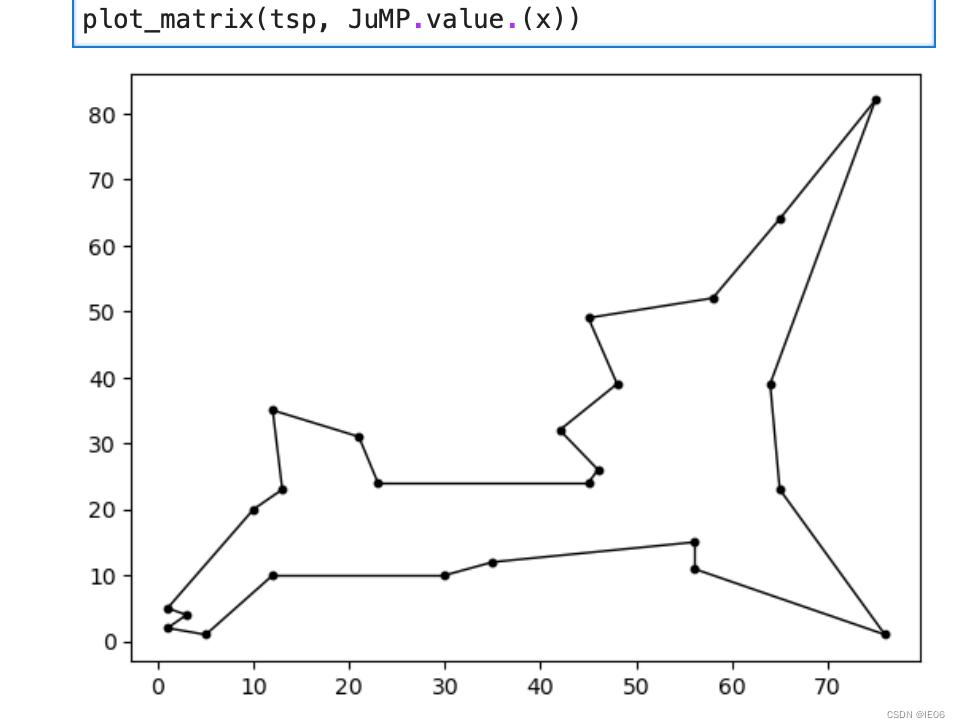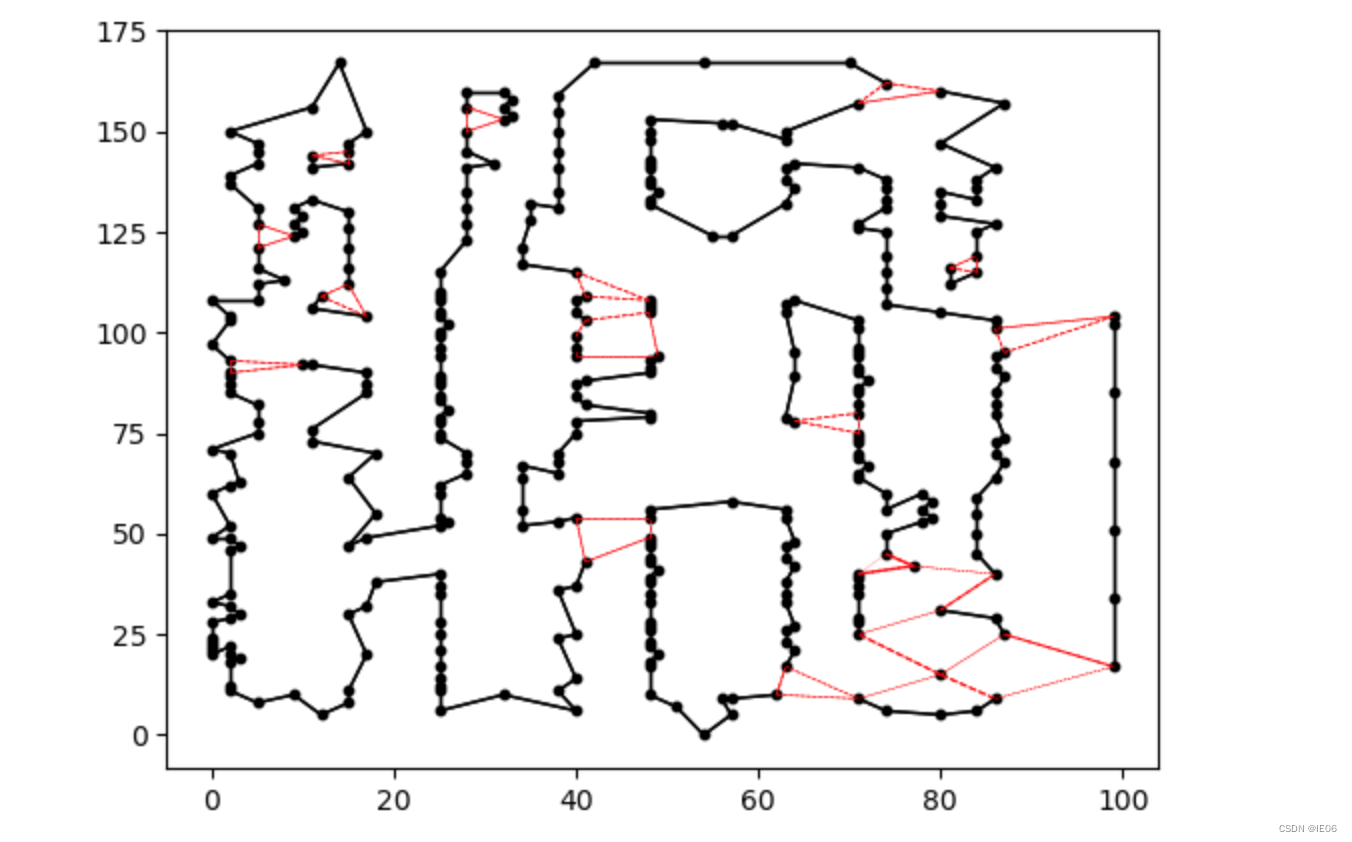1. 基础模型
使用flow约束构建基础模型
using TSPLIB,JuMP, GLPK, Distances
tsp = readTSP("25.tsp")
N = tsp.dimension
distmat = [euclidean(tsp.nodes[i,:],tsp.nodes[j,:]) for i in 1:N, j in 1:N]
m = Model(GLPK.Optimizer)
@variable(m, x[1:N,1:N], Bin)
@objective(m, Min, sum(x[i,j]*distmat[i,j] for i=1:N,j=1:N))
for i=1:N
@constraint(m, x[i,i] == 0)
@constraint(m, sum(x[i,1:N]) == 1)
end
for j=1:N
@constraint(m, sum(x[1:N,j]) == 1)
end
for f=1:N, t=1:N
@constraint(m, x[f,t]+x[t,f] <= 1)
end
optimize!(m)
结果如下:

2. subtour约束
接下来不断增加subtour约束重新求解
function is_tsp_solved(m)
g = JuMP.value.(x)
N = size(g,1)
path = Int[]
push!(path,1)
while true
v, idx = findmax(g[path[end],:])
if idx == path[1]
break
else
push!(path,idx)
end
end
n = length(path)
if n < N
@constraint(m,sum(x[path,path])<=n-1)
return false
end
return true
end
while !is_tsp_solved(m)
optimize!(m)
end
最终结果如下

整数规划还是比较费时间的,att48用了177s才求出最优解
3. 调用包求解
using TravelingSalesmanExact, GLPK
tsp = readTSPLIB(:att48)
cities = [tsp.nodes[i,:] for i in 1:tsp.dimension];
@time tour, cost = get_optimal_tour(cities, GLPK.Optimizer)
用时12.7s,主要的优化是每次同时把所有的subtour都添加进来。我们修改后的代码如下:
using JuMP, GLPK, Distances
function get_cycles(perm_matrix)
N = size(perm_matrix, 1)
remaining_inds = Set(1:N)
cycles = Vector{Int}[]
while length(remaining_inds) > 0
cycle = find_cycle(perm_matrix, first(remaining_inds))
push!(cycles, cycle)
setdiff!(remaining_inds, cycle)
end
return cycles
end
function find_cycle(perm_matrix, starting_ind = 1)
cycle = [starting_ind]
prev_ind = ind = starting_ind
while true
next_ind = findfirst(>(0.5), @views(perm_matrix[ind, 1:prev_ind-1]))
if isnothing(next_ind)
next_ind = findfirst(>(0.5), @views(perm_matrix[ind, prev_ind+1:end])) +
prev_ind
end
next_ind == starting_ind && break
push!(cycle, next_ind)
prev_ind, ind = ind, next_ind
end
return cycle
end
function is_tsp_solved(m,x)
cycles = get_cycles(JuMP.value.(x))
if size(cycles,1)>1
for cycle in cycles
@constraint(m,sum(x[cycle,cycle])<=2*size(cycle,1)-2)
end
return false
end
return true
end
function solve_tsp_with_mip(tsp)
N = tsp.dimension
distmat = [euclidean(tsp.nodes[i,:],tsp.nodes[j,:]) for i in 1:N, j in 1:N]
m = Model(GLPK.Optimizer)
@variable(m, x[1:N,1:N], Symmetric, Bin)
@objective(m, Min, sum(x[i,j]*distmat[i,j] for i=1:N,j=1:i))
for i=1:N
@constraint(m, x[i,i] == 0)
@constraint(m, sum(x[i,:]) == 2)
end
optimize!(m)
while !is_tsp_solved(m,x)
optimize!(m)
end
return JuMP.value.(x), objective_value(m)
end
@time solve_tsp_with_mip(tsp)
4. 仅使用lp求解
4.1 使用subtour约束
第一步,将所有的subtour消除:
using TravelingSalesmanExact, GLPK,TSPLIB,Distances,JuMP
function get_tours(perm_matrix, thresh = 0.1)
N = size(perm_matrix, 1)
remaining_inds = Set(1:N)
tours = Vector{Int}[]
while length(remaining_inds) > 0
tour = find_tour(perm_matrix, first(remaining_inds), thresh)
push!(tours, tour)
setdiff!(remaining_inds, tour)
end
return tours
end
function find_tour(perm_matrix, starting_ind, thresh)
tour = []
search = [starting_ind]
n = size(perm_matrix,1)
while length(search)>0
v=pop!(search)
if !(v in tour)
push!(tour,v)
for i in 1:n
if perm_matrix[v,i]>=thresh && !(i in tour)
push!(search, i)
end
end
end
end
return tour
end
tsp = readTSPLIB(:bays29); # bays29
N = tsp.dimension
distmat = [euclidean(tsp.nodes[i,:],tsp.nodes[j,:]) for i in 1:N, j in 1:N]
m = Model(GLPK.Optimizer)
@variable(m, 0<=x[1:N,1:N]<=1, Symmetric)
@objective(m, Min, sum(x[i,j]*distmat[i,j] for i=1:N,j=1:i))
for i=1:N
@constraint(m, x[i,i] == 0)
@constraint(m, sum(x[i,:]) == 2)
end
@time optimize!(m)
thresh = 0.1
tours = get_tours(JuMP.value.(x), thresh)
while length(tours) > 1
for tour in tours
@constraint(m,sum(x[tour,tour])<=2*size(tour,1)-2)
end
@time optimize!(m)
tours = get_tours(JuMP.value.(x), thresh)
end
# println(JuMP.objective_value(m))
plot_matrix(tsp,round.(JuMP.value.(x); digits=1))
最终结果如下:

4.2 使用comb约束
下面仅作例子:
function find_comb(sol, odds, starting_ind = 1)
comb = Vector{Vector{Int}}()
teeths = Vector{Vector{Int}}()
tour = Vector{Int}()
search = [starting_ind]
n = size(odds,1)
N = size(sol,1)
while length(search)>0
v = odds[pop!(search)]
if !(v in tour)
push!(tour,v)
for i in 1:n
if sol[v,odds[i]]>0.01 && sol[v,odds[i]]<0.99 && !(odds[i] in tour)
push!(search, i)
end
end
teeth = [v]
for i in 1:N
if sol[v,i]==1
push!(teeth, i)
end
end
if length(teeth)>1
push!(teeths,teeth)
end
end
end
for teeth in teeths
if !(teeth[2] in tour)
push!(comb,teeth)
end
end
push!(comb,tour)
return comb
end
function get_combs(sol)
N = size(sol, 1)
odds = Vector{Int}()
for i in 1:N
for j in 1:N
if 0< sol[i,j] && sol[i,j]<1
if !(i in odds);push!(odds,i);end
if !(j in odds);push!(odds,j);end
end
end
end
combs = Vector{Vector{Vector{Int}}}()
while length(odds) > 0
comb = find_comb(sol, odds)
push!(combs, comb)
setdiff!(odds, comb[end])
end
return combs
end
combs = get_combs(JuMP.value.(x))
while length(combs)>0
for comb in combs
k = length(comb)-1
@constraint(m,sum([sum(x[teeth,setdiff(1:N,teeth)]) for teeth in comb])>=3*k+1)
end
optimize!(m)
combs = get_combs(JuMP.value.(x))
end
plot_matrix(tsp,round.(JuMP.value.(x); digits=1))